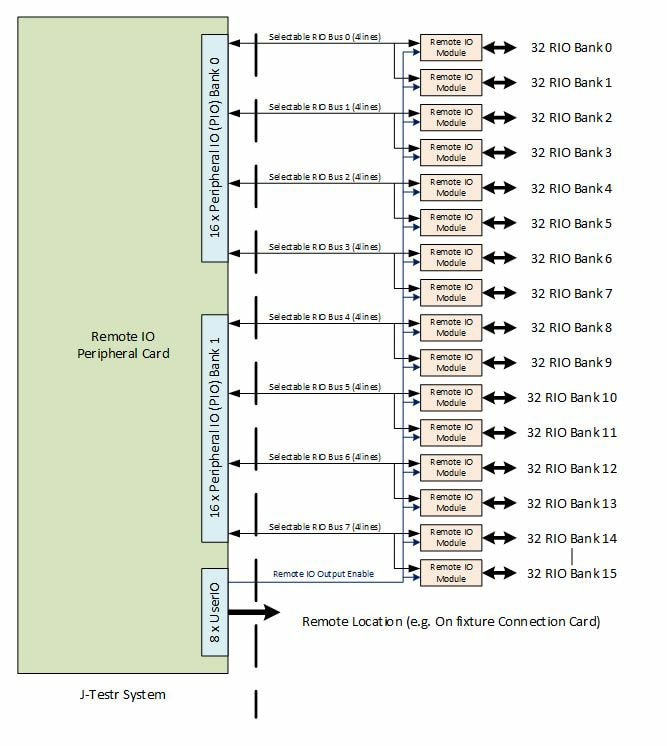Remote IO Peripheral Card
Features
|
- RIOs can ALL be changed and/or sampled simultaneously using global triggering.
- Separate programmable VccIO voltage for each RIO bank
- RIO VccIO support from 1.4V to 3.4V
- All RIOs are 5V input tolerant
- All RIOs have individual OP enable (individual open-drain/open-source capability)
- All RIOs have input over-voltage protection
- 32 ‘local’ Peripheral IOs (PIOs) in 2 banks of 16 PIOs
- Peripheral IOs can be used as ‘local’ IOs or in groups of 4 for RIO buses
- Separate programmable VccIO voltage for each PIO bank
- PIO VccIO support from 1.1V to 3.4V
- All PIOs are 5V input tolerant
- All PIOs have individual OP mode (individual open-drain/open-source capability)
- All PIOs have input over-voltage protection
- All PIO lines are designed for 50 ohms impedance
- 8 User I/O with UART, SPI, I2C, PWM and GPSM features (VccIO shared with PIO bank 0)
About
The J-Testr Remote IO peripheral card provides a unique architecture to allow up to 512 ‘Remote’ IOs (RIOs) to be placed very close to the UUT. This saves significant cabling resources, cost and development time, whilst also increasing reliably. This is especially true when coupled with the J-Testr+ GTI test system utilising the EZ-Wired concept. The Remote IO peripheral card converts up to 32 ‘local’ Peripheral IO (PIO) lines into up to 512 Remote IOs that can be placed near the UUT where required.
The standard well established and reliable JTAG bus is used as the communications bus to the RIO modules. Either one or two RIO modules can connect to each bus. The peripheral card firmware automatically detects how many modules are attached to each bus and tests the connection during the enabling stage of the communications buses. RIO modules can be re-purposed for direct use with other JTAG test systems if required.
Each RIO module has 32 bidirectional, protected and 5V tolerant IOs packaged in a small 51mm x 35mm module with a single standard 2mm pitch header for easy integration as a piggy-back card. Each RIO module has a ‘global’ output enable line to enable/disable all 32 IOs. The ‘global’ output enables of all RIO modules can be connected to one or more User I/O lines thus making all RIOs 100% compatible with the J-Testr J-Safe protection scheme. Global triggering is provided to allow ALL 512 RIOs to be changed and/or sampled simultaneously.
The RIO module only requires a single 5V supply, which is readily available on all J-Testr test systems. The VccIO voltage of each RIO module can be set, between 3.4V and 1.4V, with a single resistor1 attached between the VccIO power output and VccAdj pins.
Each RIO module has 32 bidirectional, protected and 5V tolerant IOs packaged in a small 51mm x 35mm module with a single standard 2mm pitch header for easy integration as a piggy-back card. Each RIO module has a ‘global’ output enable line to enable/disable all 32 IOs. The ‘global’ output enables of all RIO modules can be connected to one or more User I/O lines thus making all RIOs 100% compatible with the J-Testr J-Safe protection scheme. Global triggering is provided to allow ALL 512 RIOs to be changed and/or sampled simultaneously.
The RIO module only requires a single 5V supply, which is readily available on all J-Testr test systems. The VccIO voltage of each RIO module can be set, between 3.4V and 1.4V, with a single resistor1 attached between the VccIO power output and VccAdj pins.
The Remote IO peripheral card has 32 Peripheral IOs (PIOs) which are split into two banks of 16 PIOs with each bank having an individually programmable VccIO. Each PIO line is programmable to be either ‘standard IO’ or a ‘remote IO communication bus line’ thus allowing maximum flexibility in having a combination of PIOs and RIOs when not all RIOs communication buses are required. Note however that PIOs must be used in groups of 4 when used for RIO module communication (via the 4-wire JTAG bus protocol).
Finally, as with all bus connected peripherals, the peripheral provides 8 general purpose User IOs which can be used to control and/or read custom circuitry on the interposer or UUT. The IOs can provide special hardware functions such as 16-bit PWM, UART, SPI, I2C and GPSM (General Purpose Signal Monitor for measuring freq/duty/pulse-width etc.) that can be multiplexed to any of the User IO pins. Note that the User IOs share the same VccIO as the bank 0 PIOs.
Note 1: No resistor being fitted sets the RIO VccIO to the default of 3.4V




